Hipsters is excited to present Magic and Meaning, Jacob Torbeck’s dive into myth and meaning in a new series seeking to explore the relationship between Magic and culture.
The way pop culture engages with, appropriates, and even influences the way we make sense of deep questions of meaning has been one of my academic preoccupations as a student and now as a professional researcher in theology and ethics. In his second-to-last scripted video for the PBS Idea Channel, “A Defense of Overthinking Pop Culture,” Mike Rugnetta argues that no cultural object is devoid of meaning that goes beyond itself: media in any form—whether films, games, comics, etc.—are not only sources for philosophical work but also do that work themselves.
As a longtime Magic player, it’s a great pleasure of mine to analyze new sets and enjoy the layers of meanings—both intentional and unintentional—that show up in the cards. For Ikoria: Lair of Behemoths, though, I was initially uninspired. Flavor-wise, both the comic-book style and Godzilla alternate art seemed to take me out of the game world I knew and loved. The weirdness and complexity of the mutate mechanic and ability counters grated against my preference for sleek design.
Something changed, however, as time wore on. I found myself watching Godzilla movies and pondering the weirdness of this set’s collaboration with Toho in conjunction with the weirdness of our collective moment. One of my fundamental premises is that Magic: the Gathering, as a product of pop culture, not only borrows from but contributes to our worlds of shared meaning. Furthermore, even settings with stories as thin as Ikoria’s are fertile ground for thinking about big questions. So what might Ikoria offer us?
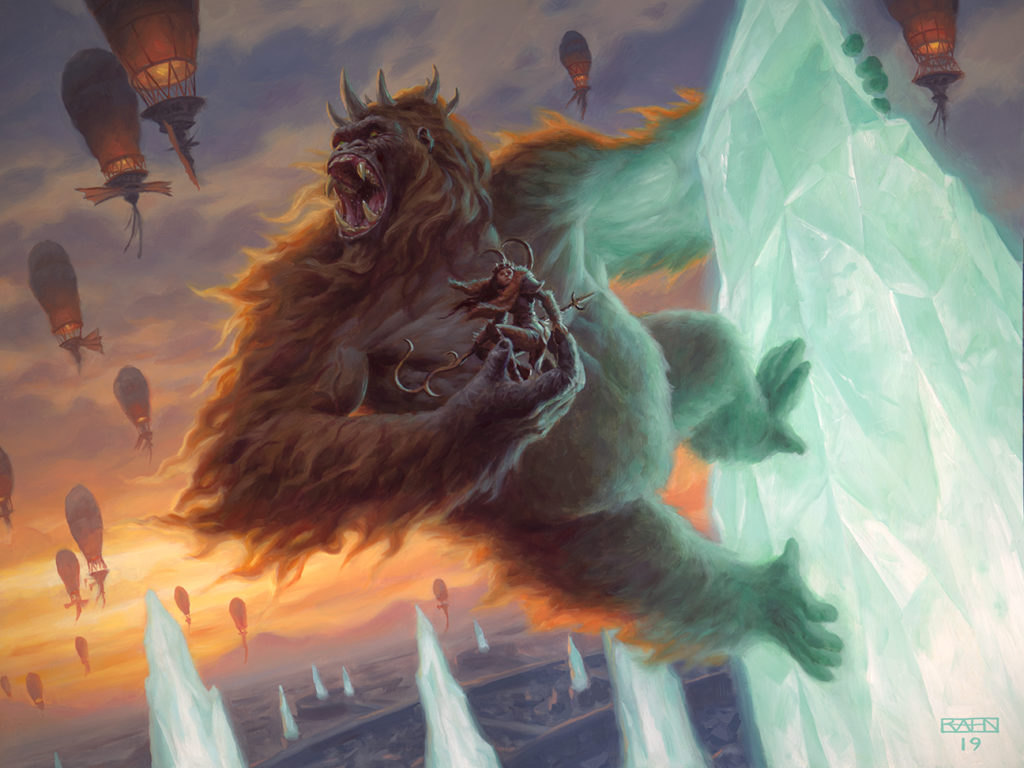
Kogla the Titan Ape by Chris Rahn
Monster Movie Magic
Before we take a look at where the “deeper meanings” of this set really shine, I want to set out a consistent thread of meaning when it comes to the concept of “behemoths.” While the term “behemoth” has come to be used generically to mean just about any “great beast,” it’s familiar use in contemporary culture was initially derived from the book of Job, where a particular Behemoth is mentioned alongside its aquatic sister, Leviathan. Unlike a dragon, which legends say can be slain by a solitary hero, the power of Behemoth and Leviathan are beyond human reckoning. Near the end of the book, these massively powerful, primordial creations of God are used to prove a very basic point to Job and the readers: the world is wild, uncontrollable, and beyond our ability to master, humbling us as soon as we think we’re on top. And yet, there’s hope of surviving even this.
The setting of Ikoria seems to introduce us to a world in which this lesson is the fundamental reality for all humans. Massive creatures roam the wilds, waging destructive rampages against human settlements frequently enough that humans have erected bastions and safe-havens designed to shelter them from these powerful creatures. They survive by isolating themselves in the air, behind walls, or even between rivers of lava. The plane leans into both definitions of “behemoth,” featuring a host of smaller—but still formidable—beasts, as well as the gigantic Apexes, archetypal beasts whose transcendent power spawns their own mythoi.
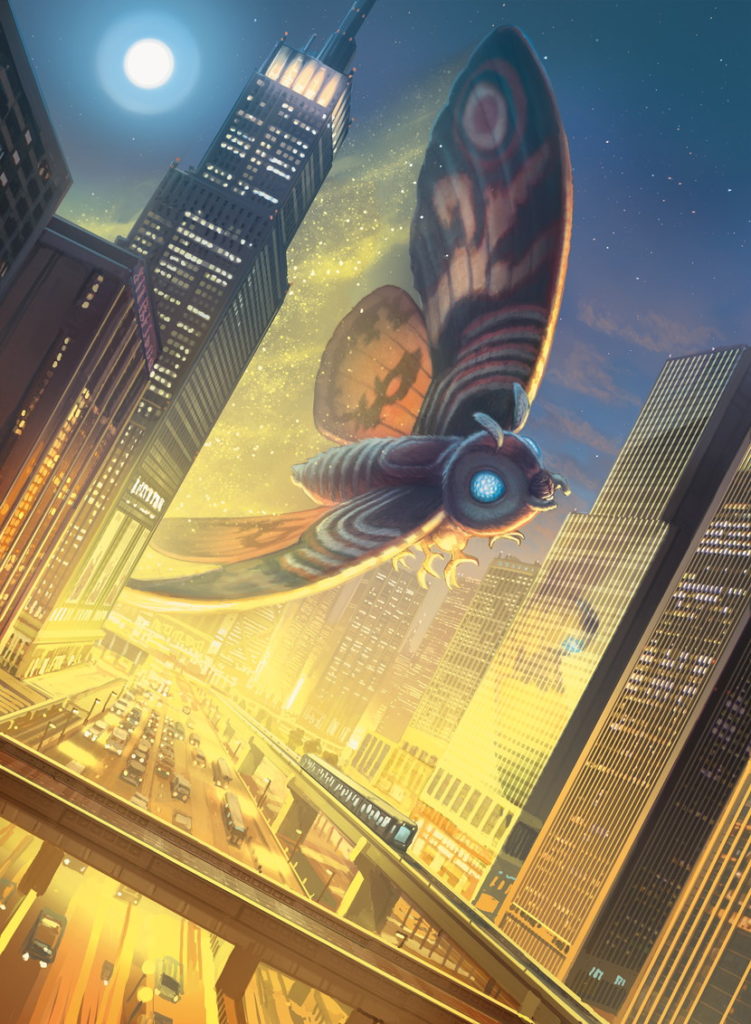
Luminous Broodmoth / Mohtra, by Nick Southam
Additionally, with Ikoria, Wizards of the Coast has collaborated with Toho to bring us alternate art versions of cards featuring creatures from Kaiju films, like Godzilla and Mothra. Adding these characters, which come with their own histories, intensifies and deepens the theme of power beyond human control to a marvelous degree. Kaiju Eiga (kaiju films) have explored this motif over the course of decades of cinema, speaking to numerous global events and zeitgeists that draw from the rich cultural heritage of Japan. Attempting to interpret the meaning of Godzilla across more than 60 years and vastly different cultural contexts is an audacious task, but I agree with Godzilla scholar Theodore C. Bestor that there is at least one constant and undeniable thing that Godzilla does well and repeatedly:
He brings modern civilization to its knees.
Far from a mere movie monster, Godzilla and the rest of the Toho Kaiju are creations laden with spiritual and political meaning. In the epilogue of In Godzilla’s Footsteps, Bestor stresses that myths help us make sense of the world—they give us meaning and stories to make sense of extreme experiences. As a myth, Bestor argues, “Godzilla raises all the right questions: east and west; south and north; primitive and modern; rural and urban; tradition and cosmopolitanism; left and right; religion and science; war and peace.”
In 1954 when Gojira was released to Japanese theatres, the country was in the midst of negotiating Japan’s past, present, and future. While the memory of the immense devastation of the atomic bomb was fresh in the minds of Japanese citizens, so too was American occupation, and the Lucky Dragon No. 5 incident, in which the ashen fallout from the United States’ bomb testing off of the Bikini Atoll was carried beyond the expected danger zone and rained down on the twenty-three strong crew of the fishing boat. In the wake of these constant tragedies, Japan struggled with questions about the meaning of its relationships with the outside world; as well as to traditional social values and beliefs, like Shinto, and how best to move forward in the years to come.
Gojira debuted not just as an entertaining monster movie, but as the inauguration of a new mythos that drew on elements of Japan’s cultural past and present. When Godzilla emerges from the sea, he is accompanied by a theophany: an earthquake and a typhoon. Like the Behemoth and Leviathan, Godzilla is said to be kami-like, a natural force of destruction, spoken of in ancient local legends. At the sight of this ancient threat, local villagers perform a ritual that Bestor identifies as “a traditional kagura-like dance, at the local Shinto shrine, to ward Godzilla off.” The ritual fails, possibly reflecting a cultural fear that Japan is losing its traditional values, or its awareness of spiritual presence in the world.
The film quickly turns political, however, as politicians on either side disagree about how to face the monster: populists argue for transparency, while conservatives want to keep the news of impending disaster under wraps as much as possible. There is no time for either, however, as Godzilla arrives on the shore, announcing himself to all, and defying the armed defense forces. Bestor summarizes the turn this way:
And so, from the murky depths of Japanese tradition rooted in remote rural life, the dragon sets forth to attack Japan’s urban core. The awakened monster of the deep/of deep tradition cannot be vanquished by Japan’s most advanced science and industrial technology.
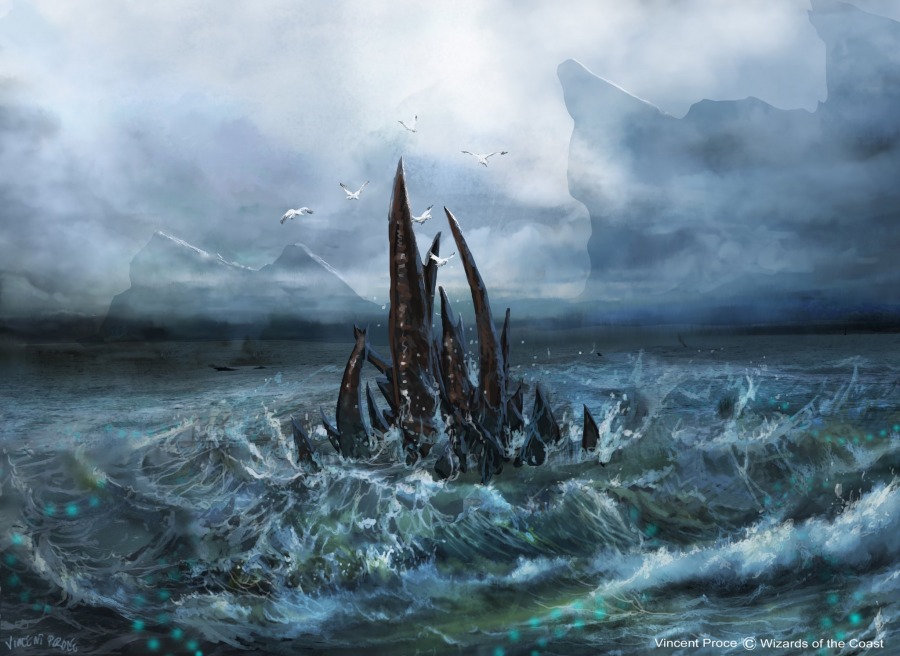
Ominous Seas by Vincent Proce
In addition to foregrounding this struggle between the old and the new spiritual and political orders, Gojira presents the creature as roused from his slumber by nuclear radiation. His emergence from the sea as an unstoppable force of destruction is a symbolic rebuke of nuclear power and a warning against nuclear war. In the words of Gavi, Nest Warden on the flavor text for Eerie Ultimatum, “The ground under our feet is a record of every slight against the world, to be avenged at a time of its choosing.”
Japanese audiences initially saw the film Gojira as an homage to all the victims of those nuclear bombings, and a warning against further nuclear testing. In an interview promoting the forthcoming documentary The Dawn of Kaiju Eiga, producer August Ragone explains that “after returning to a defeated Japan from China as a POW, Hondo [the director] passed through the ruins of Hiroshima, and thought to himself that this was surely a sign of Armageddon, the end of the world at our own hands. Director Hondo himself said that Godzilla was the corporeal embodiment of war itself.” Furthermore, Ragone continues, along with the crew of the Lucky Dragon no. 5, “Godzilla was created to be depicted as a victim of the Bikini Atoll testing as well, with his skin covered in keloid scars, and the ability to exhale nuclear death.”
Are we the baddies?
When I first saw the spoilers for Ikoria, I and at least a handful of others offered the opinion that it was perhaps the most like an Un-set that we’d ever seen in Standard. Cards like Shark Typhoon, a thinly-veiled reference to Sharknado!, the SyFy original movie which satirizes disaster horror, seem to be winking at the players, defying us to take this seriously. Additional references to King Kong, Jaws, and other films strike me as along the same lines as many of the fairy-tale inspired cards from Throne of Eldraine. Rhystic Studies has already done a marvelous job discussing the power of the fairy tale references there, but we’d surely be kidding ourselves if we didn’t also catch references to Monty Python and the Holy Grail and Shrek. Satire sits side by side with seriousness, threatening even to overtake it.
When it comes to these stories, perhaps something has been irrevocably lost in translation: 60 years ago, initial American reviews of Godzilla: King of the Monsters! described the film as kitschy, cheesy, and bizarre. Rather than finding it silly or laughable, initial reviews of Gojira in Japanese publications Asahi Shimbun and Kinejun took the message to heart, calling the film “dark” and saying that it left a bad taste in their mouths. We can note a similar disparity between the English language trailer for Ikoria—which features Vivien Reid battling a mutating monstrosity to Joan Jett’s “Bad Reputation” with a characteristically confident swagger—and the Japanese commercial, which proclaims in its narration:
In a world of ruin and chaos… Humans have lost hope and become obsessed with rivalry. […] It became pure fear, created by humans. As the giant beast stood before us, we humans could only do one thing: run for our lives. Its name? Godzilla! Humans, rise up!
In addition to this cross-Pacific tonal difference in reception; in this set, as in many Magic sets, the layers of dramatic fantasy are made easier to consume by a healthy distribution of “cheese.” As Annalee Newitz puts it, “cheese” allows us to enjoy sometimes uncomfortable truths without guilt by mediating them with satire. Wait, what? Guilt?
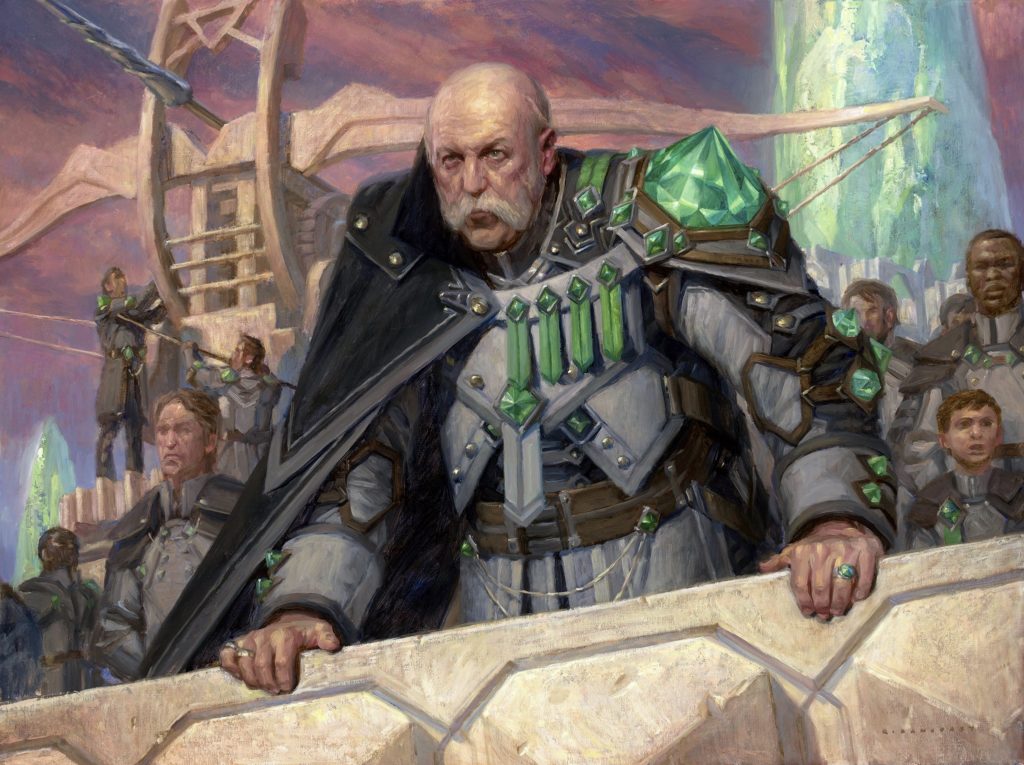
General Kudro of Drannith, by Ryan Pancoast
One of the key themes of horror films, whether Japanese or American, is that the monstrous is seen as monstrous precisely because it is an “other.” However, there is often another theme—the notion that we are the true monsters. The story of Ikoria plays with this notion, as well: The humans of the walled city of Drannith (centered in Mardu colors) lash out in fear at monsters and anyone who bonds with them. Even Lukka, once outcast, sees the monsters as tools for his revenge. The true conflict in Ikoria’s novel, Sundered Bond, is not man vs. monster, but man vs. man; Lukka opts to wipe Drannith from the map and start anew, having lost faith in humanity’s ability to change. Likewise, in the Toho films, Godzilla is not just an intruder from Japan’s south seas, but, as Bestor points out, “he is also a primordial ‘other’ from the inside. He is Japanese!”
In real life, much like the humans and monsters in Ikoria, our rivalry with one another erupts into conflict, and Godzilla emerges as a symbol of this conflict which threatens to destroy us all. The opening line of the Japanese trailer sounds post-apocalyptic but resonates—as good post-apocalyptic media does—with our current moment. As Bestor puts it, Godzilla invites us to consider that “destruction is all around us, some of it wrought by nature, some by humans, often compounded by the incompetence (or arrogance) of humans who think they have conquered, tamed, or contained the furies of nature of nature or the furies of their fellow human beings.”
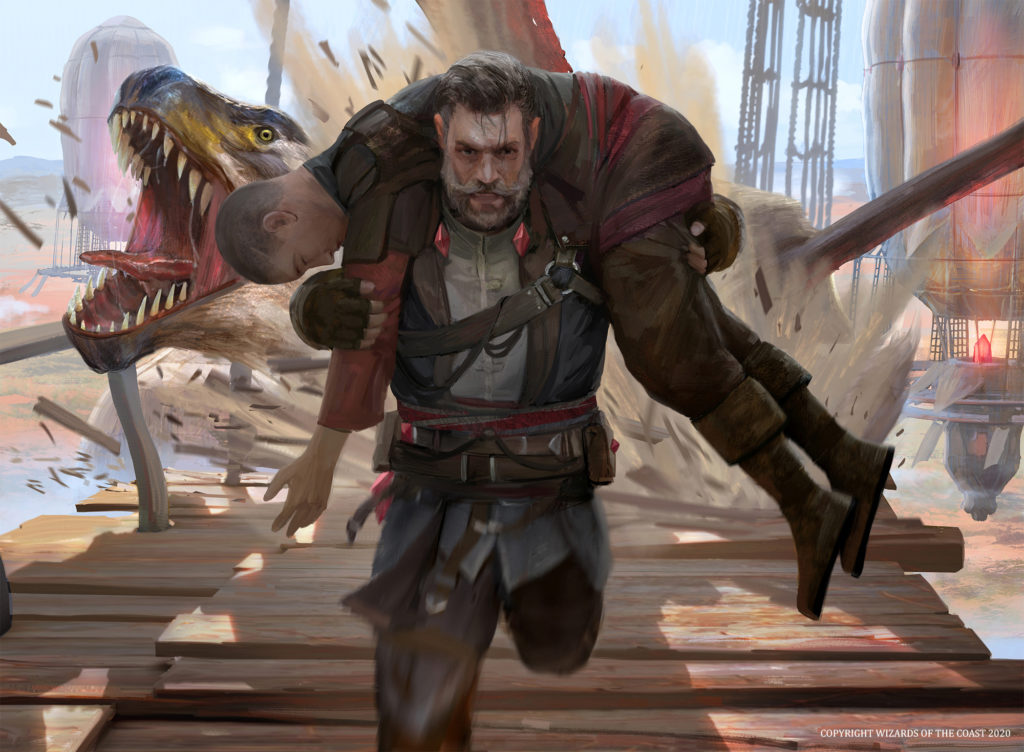
Valiant Rescuer by Bram Sels
Ideological polarization is currently intense, and there are legions of twitter bots and media personalities that hope to accumulate power and influence by turning people against one another. The Japanese trailer for Ikoria declares that Godzilla is an incarnation of pure fear, and our doom is inevitable unless we band together and rise up. In this way, Ikoria asks us to think about how we—humbled like Job in the face of uncontrollable forces—can put aside rivalry for the sake of unity, and drive the monsters back beneath the waves.
For further reading:
Newitz, Annalee. “What Makes Things Cheesy?: Satire, Multinationalism, and B-Movies.” Social Text 18, no. 2 (2000): 59-82.
Tsutsui, W., and Ito, M., eds. In Godzilla’s Footsteps: Japanese Pop Culture Icons on the Global Stage. New York: Palgrave MacMillan, 2006.
Jacob Torbeck is a researcher and instructor of theology and ethics. He hails from Chicago, IL, and loves playing Commander and pre-modern cubes.

